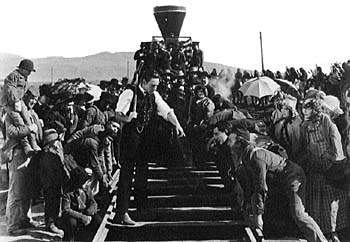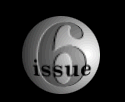|
"The Blood of America is the blood of the Pioneers," the film’s opening credits boldly exclaimed before relating the story of a 2,000 mile wagon trek to the promised land of California. Grand-scale photography and panoramic settings conveyed the journey in such monumental terms as to make it seem a veritable Genesis of American culture. If Andre Bazin saw at the heart of the Western "the ethics of the epic and even of tragedy" (147) and an overriding style with a "predilection for vast horizons, all encompassing shots [and] virtually no use for the close-up" (147), he may simply have been referencing The Covered Wagon alone. The success of the film led to a direct and lasting rejuvenation of the genre. In the following year the number of Westerns produced had tripled (Fenin and Everson 132).

George O'Brien leads the workers in The Iron Horse.
Fox’s The Iron Horse (1924) directed by John Ford was one such film. Perhaps the greatest Western of the late-silent period -- and certainly the most expensive -- The Iron Horse told the tale of the building of the transcontinental railroad. Turning history into epic, the film was as legend-building as The Covered Wagon, with an equally fine pictorial sense and a greater grasp of drama and tension. As a John Ford film, it was to mark the culmination of the director’s early work at Universal and Fox, foreshadowing the successful blending of action, comedy, romance and myth that would characterize many of his later great films in the genre. Indeed, in the mid-'50s Ford would call it his personal favorite of all his films (Fenin and Everson 136).
The industry’s willingness to produce films such as The Iron Horse -- and also The Pony Express (1925) and The Winning of Barbara Worth (1927) -- displayed a newfound security in the genre, which percolated down to even the most ragged productions. Working under the shadow of Universal, MGM, and First National, shoestring budget studios such as Artclass, Anchor, Sierra, and Sunset were surviving solely on the box-office draw of their Westerns. And with this flood of "A" and "B" Westerns there sprung a welter of new stars -- Harry Carey, Buck Jones, Fred Thompson, 12-year old Buzz Barton, Tom Mix’s daughter, Ruth, and a litter of K-9 stars, including Rinty, Peter the Great and, of course, Rin Tin Tin. Behind the rolling cameras directors such as William Wyler, William K. Howard, and Raoul Walsh served their apprenticeships, working their way up from two-reelers to feature films to international acclaim. On the cusp of a new era, the Western was fizzing over with energy and optimism.
In 1927 Warner Brothers scored a hit with The Jazz Singer, the screen’s first legit "talkie." By 1929, three-fourths of all the films produced were all-talking (Cook 249), and by the early 1930s, silent films were a distant memory. Gene Autry and Roy Rogers would become the new Western stars, as apt to break out in song as charge into a saloon brawl. The increasing maturing of John Ford and Howard Hawks -- alongside regular contributions from Anthony Mann, Budd Boetticher, and later, Sam Peckinpah, combined with the "star quality" of John Wayne and Clint Eastwood -- provided the genre with the fuel it needed to reflect and inform America’s view of itself and its history.
page 7 of 8
 
Page 1 The Myth and Pre-History of the Silent Western
Page 2 Prospecting: The Edison Co. and Edwin S. Porter
Page 3 Trail-Blazing: Broncho Billy Anderson, the Genre's First Cowboy
Page 4 Pioneering: Griffith, Ince and the Western as Art and Commerce
Page 5 Frontiersman: William S. Hart and Western Realism
Page 6 Showmanship: Fairbanks, Mix and Jazz Age Cowboy
Page 7 Epic Mythmaking: Cruze and Ford and the End of the Silent Era
Page 8 Conclusion
[Works Cited]
Other Western articles in this issue:
The Western Menu Page
The Western: An Overview
The Silent Western as Mythmaker
Spaghetti Westerns
Western Web Links
|


